Quanzhou Ancient City (泉州古城), historically known as Wenling, Citong, and Licheng, is located in Licheng District, Quanzhou City, Fujian Province. It is renowned as the “City of Literature,” the “Museum of World Religions,” and the “Showcase of Multiculturalism.” Recognized as one of the first National Famous Historical and Cultural Cities and a World Heritage City, it was also the inaugural East Asian Cultural Capital.
Covering an area of 6.41 square kilometers, the ancient city boasts an impressive array of cultural and historical sites. It includes 8 World Heritage Sites, 8 National Key Cultural Relics Protection Units, 14 Provincial Cultural Relics Protection Units, 35 Municipal Cultural Relics Protection Units, and 669 traditional buildings and modern historical landmarks.
Quanzhou Ancient City began its development during the prosperous Tang Dynasty and continued to expand through the Five Dynasties, Song, Yuan, and Ming Dynasties, driven by thriving overseas transportation and foreign trade. During the Song and Yuan periods, Citong Port’s maritime trade flourished like never before, with a bustling scene of ships and merchants from all over the world. This era left behind the vibrant image of a bustling port, famously described as “a market filled with people from ten continents.”
Today, the core area of this historic city still preserves a wealth of historical relics and well-maintained ancient urban patterns. These “living memories” allow visitors to look back at the city’s glorious past and experience the rich historical and cultural heritage of this millennia-old city.
Table of Contents
- Basic Information
- Location and Transportation
- Highlights of Quanzhou Ancient City
- Vlog about Quanzhou Ancient City
Basic Information
| Estimated Length of Tour | 1 day |
| Ticket Price | The area is free, but you need to pay for the various attractions |
| Opening Hours | The area is accessible 24 hours a day, but most attractions operate from 8.00 to 17.00 |
Location and Transportation
Quanzhou Ancient City is located at 42 Zhongshan Middle Road, Licheng District, Quanzhou City, Fujian Province, China. To get to the center of the area, you can take bus 4, 6, 14, 19, 24, 25, 26, 33, 41, or 601 and get off at Fuwenmiao Stop (府文庙站).
Highlights of Quanzhou Ancient City
Quanzhou Confucian Temple
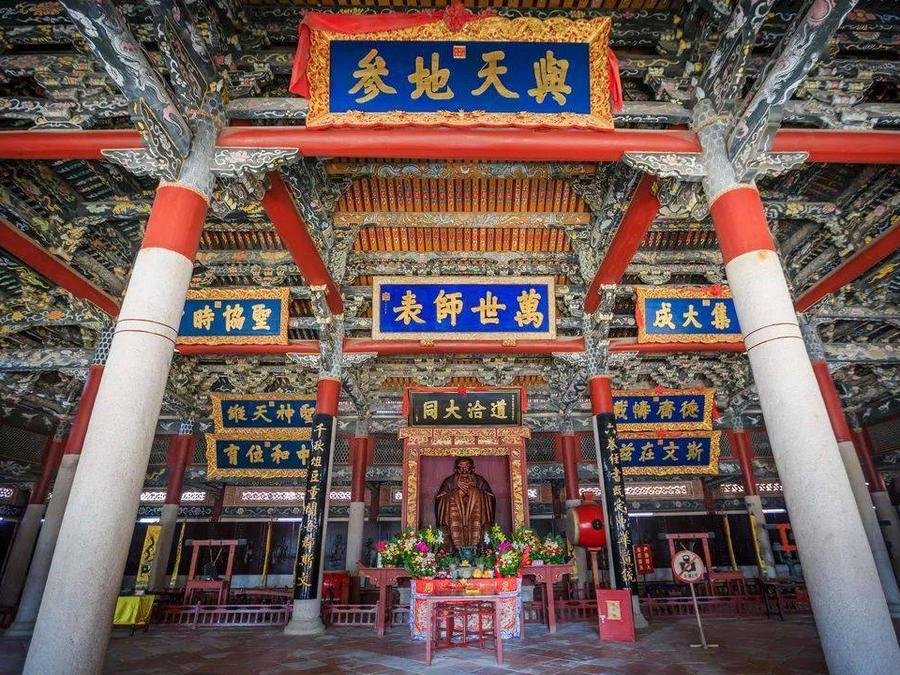
The Quanzhou Confucian Temple, also known as Quanzhou Fu Wenmiao, was originally constructed during the early Northern Song Dynasty in the Taiping Xingguo period (976 AD). The current architectural layout primarily dates back to the major reconstruction undertaken in the 26th year of the Qianlong reign (1761) during the Qing Dynasty. This temple complex encompasses architectural styles from the Song, Yuan, Ming, and Qing dynasties, making it one of the most complete and significant Confucian temple complexes in southeastern China.
The complex is aligned north to south, with a symmetrical courtyard layout featuring the temple (Wenmiao) to the west and the academy (Xuegong) to the east. The temple is dedicated to Confucian worship, while the academy served as a local educational institution. Additionally, surrounding the two main sections are ancestral halls dedicated to notable historical figures of Quanzhou from the Ming and Qing dynasties. The complex retains the architectural essence of the Song dynasty, making it a vital cultural and historical site in Quanzhou.
Quanzhou Yuanmiao Temple
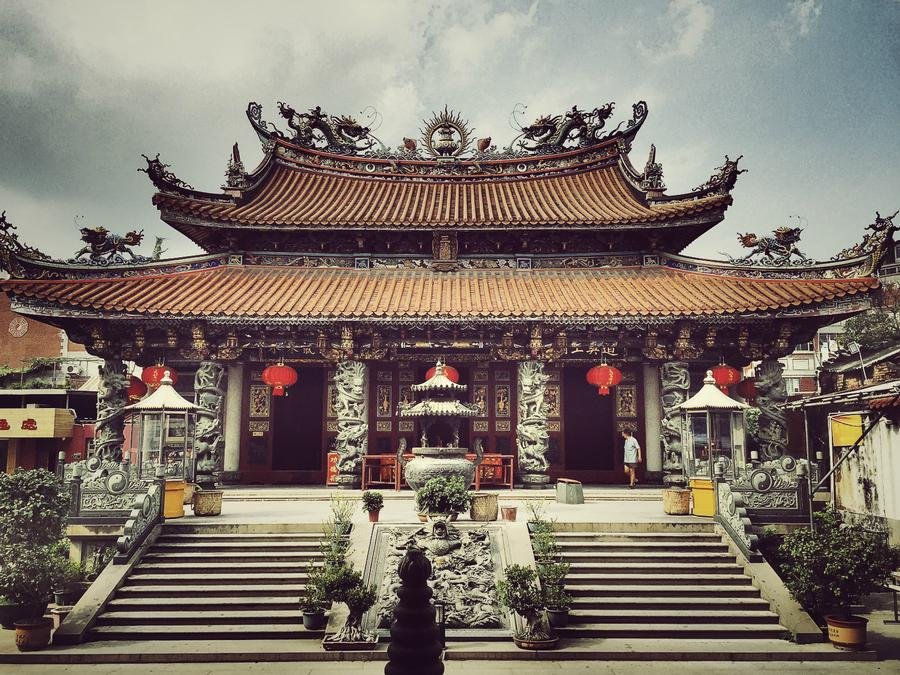
Quanzhou Yuanmiao Temple, originally named Baiyun Temple, was established during the Taikang period of the Western Jin Dynasty (280–289 AD). It holds the distinction of being the first Taoist temple in Fujian after the religion spread to the province, earning it the title of “First Taoist Temple of Fujian.” Over the centuries, the temple underwent numerous renovations and expansions, and its name changed several times, including Zhongxing Temple, Longxing Temple, Tianqing Temple, and finally Yuanmiao Temple.
Historically, Yuanmiao Temple was an extensive complex covering over 10,000 square meters. It featured various buildings such as the Screen Wall, Mountain Gate, Xuantan Shrine, Kangwang Shrine, Sanqing Hall, Laojun Shrine, Nantian Gate, Lingxiao Hall, Wenchang Mansion, Long Corridor, Seven-Star Well, and a Theatre Stage. It served as the center of Taoist activities in southern Fujian, with the Taoist Affairs Bureau of the Ming and Qing dynasties located within its premises. Ceremonies for conferring Taoist titles and ordinations were also held here, underscoring its significance in the regional religious landscape.
Quanzhou Chenghuang Temple (City God Temple)

Quanzhou Chenghuang Temple, dedicated to Han Qi as the City God, is located at the intersection of Mofan Alley and Xianhou Street (present-day Xincun Primary School). Commonly known as the “Great City God Temple,” it was initially built in 1057 during the Northern Song Dynasty and originally named Minglie Wang Temple. The temple was relocated and rebuilt several times throughout history, with significant renovations occurring during the Ming Dynasty (1370-1371) and later periods.
By the Qing Dynasty, extensive reconstructions led to the temple’s current form, featuring a grand complex that includes the Mountain Gate, Front Hall, Middle Hall, and Rear Hall. The temple occupies over ten acres and mirrors the architectural style of government offices, showcasing a majestic and grand appearance. Historically, the temple has been a central Taoist site in Quanzhou, frequently hosting rituals for rain and fair weather. The temple’s influence extends to other county Chenghuang Temples in Quanzhou Prefecture, which annually visit to pay homage and receive incense.
Quanzhou Kaiyuan Temple

Quanzhou Kaiyuan Temple, originally established in the 7th century, reached its present scale in the 10th century. It retains the early typical layout of large ancient Chinese Buddhist temples, with the unique feature of having pagoda courtyards on both the east and west sides of the main courtyard. This architectural design is a rare and precious example from the formative period of Chinese Buddhist temple construction.
The temple is aligned north to south, with the main buildings along the central axis, including the Ziyun Screen, the Hall of Heavenly Kings, the Worship Pavilion, the Great Hall, the Ganlu Precept Altar, and the Sutra Library with its Patron Hall to the east. The eastern and western sides are marked by the Song Dynasty stone pagodas, Zhen Guo Pagoda and Ren Shou Pagoda. Covering an area of about 80,000 square meters, Kaiyuan Temple is a testament to the grandeur and historical significance of ancient Buddhist architecture.
Quanzhou Twin Pagodas
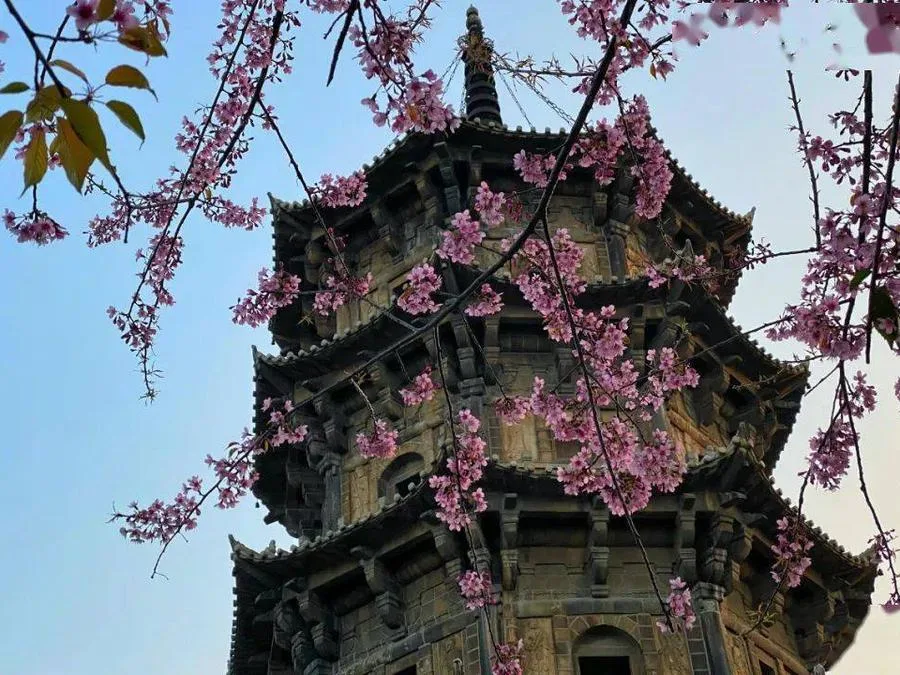
The Quanzhou Twin Pagodas, located within the Kaiyuan Temple complex, are prominent landmarks in Quanzhou Ancient City. The twin pagodas stand approximately 200 meters apart, with the eastern pagoda known as the Zhen Guo Pagoda and the western pagoda called the Ren Shou Pagoda. These pagodas are considered the jewels of southern Fujian’s pagodas.
Initially built as wooden structures during the late Tang and Five Dynasties periods, the pagodas were later rebuilt using brick and stone. The western pagoda was reconstructed as a stone pagoda during the first year of the Southern Song Dynasty’s Shaoding era (1228 AD), taking ten years to complete. The eastern pagoda’s reconstruction began in the second year of the Jiaxi era (1238 AD) and took twelve years to finish. The eastern pagoda stands 48.24 meters tall, while the western pagoda reaches 44.06 meters. Despite enduring several earthquakes and typhoons over the past 700 years, the pagodas have remained intact, demonstrating the high level of architectural and stone carving skills of the Song Dynasty. They are considered treasures of ancient Chinese stone architecture.
Quanzhou Qingjing Mosque

The Quanzhou Qingjing Mosque, also known as the Ashab Mosque or the Mosque of Purity and Tranquility, is one of the oldest Islamic mosques in China. Situated on Tumen Street in the city center, the mosque covers an area of 2,078.36 square meters. It was designated a National Key Cultural Relic Protection Unit in March 1961.
The mosque was built during the second year of the Northern Song Dynasty’s Dazhong Xiangfu era (1009 AD), making it one of the oldest surviving Islamic structures in China. The mosque complex consists of three main parts: the entrance gate, the Worship Hall, and the Mingxin Hall. The architectural style of the Qingjing Mosque reflects the influence of Arabic design, making it a significant historical and cultural site in Quanzhou. The mosque’s ancient presence attests to Quanzhou’s role as a major port city and a hub of cultural exchange during the Song and Yuan dynasties.
Deji Gate Ruins
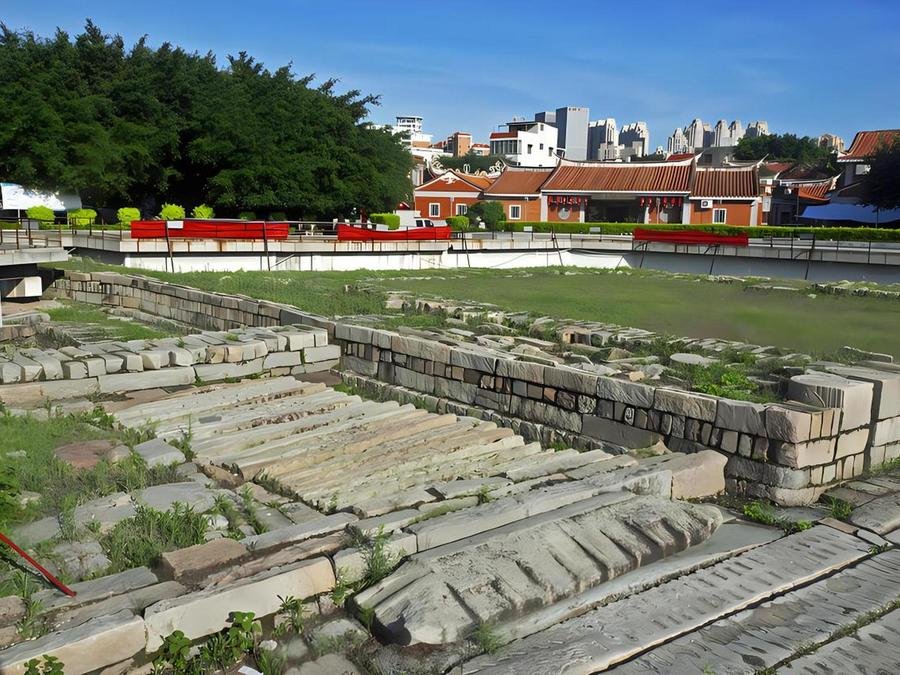
The Deji Gate Ruins are located in the central area of Quanzhou, in front of the Tianhou Temple on Tianhou Road. This site is one of the largest and longest-used stone city gate ruins in China, covering an area of approximately 2,500 square meters. The cultural layers from the Song, Yuan, Ming, and Qing dynasties are superimposed, revealing the historical development of the city from the 11th to the 20th century. Excavations have uncovered remnants from each era, showing the continuous expansion and reconstruction over centuries.
From north to south, the site includes relics of the Southern Song city wall, an inner moat and ancient arch bridge, Yuan and Ming city walls and gate, a Ming-era walled city, and an outer moat. The overall layout indicates a trend of southward expansion. The Deji Gate Ruins are significant for understanding the urban development and architectural styles of Quanzhou through various historical periods.
Wei Yuan Building
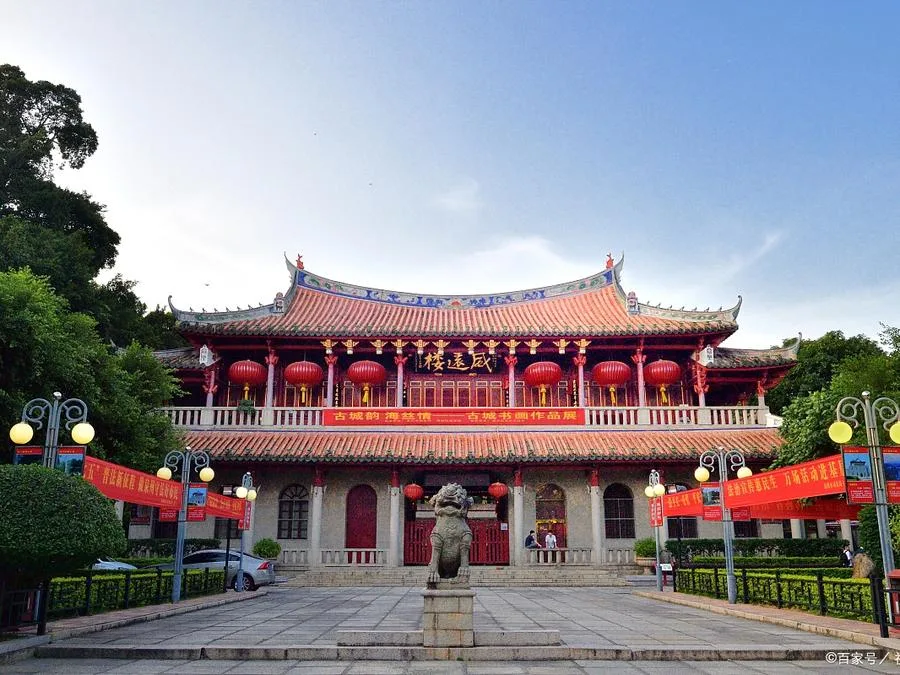
The Wei Yuan Building, also known historically as the “Chao Tower” or “North Tower,” is another significant landmark in Quanzhou Ancient City. Originally, this building served as the northern gateway to the city and was a symbol of the city’s prosperity during the Tang and Song dynasties. The building was initially located 90 steps south of the provincial administrative office’s main gate, earning its name “Wei Yuan Building” during a renovation in the Yuan dynasty.
The building suffered a fire during the Ming dynasty, leading to its relocation northward to the provincial administrative office’s main gate for reconstruction. Despite three renovations during the Qing dynasty, by the end of the Qing dynasty and the early Republican era, the building had deteriorated significantly. In 1958, it was completely rebuilt, but it was severely damaged again during the Cultural Revolution, ultimately being demolished. In 1986, the Quanzhou municipal government decided to reconstruct the Wei Yuan Building, moving its location 100 meters north.
Dingxin Tower

Dingxin Tower, also known as Chengxin Tower, is located in the center of the city at Wan Hou Pu. Built during the Ming dynasty’s Wanli period (1573-1620) and renovated in the 14th year of the Qing dynasty’s Qianlong period (1749), this five-story, octagonal pagoda stands approximately 4.5 meters tall with a side length of about 0.75 meters. The tower is constructed from red bricks and coated with white plaster. Its roof features a decorative finial made of red ceramic pots, also coated with white plaster, forming a gourd-like shape. The base of the tower, made of granite, includes inscriptions on one side that read “Namo Amitabha” and on the other side, “Rebuilt in the 14th year of Qianlong’s reign (1749).”
Chengtian Temple
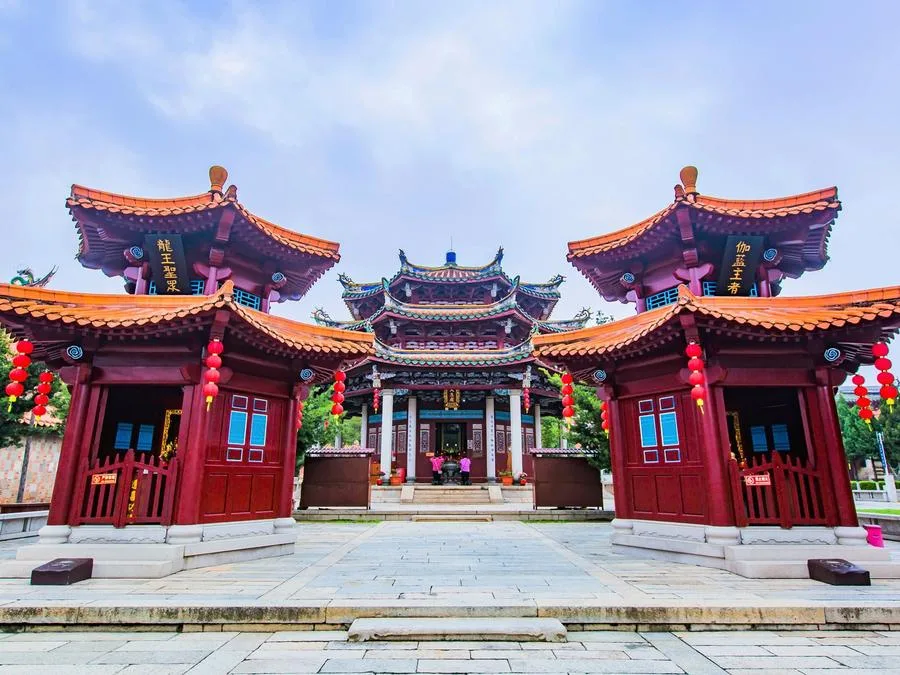
Chengtian Temple, also known as Yuetai Temple, is situated southeast of Chongyang Gate, along the east side of Nanjun Lane. With a history spanning over a thousand years, the temple has been rebuilt multiple times, growing in scale with each reconstruction. It stands alongside Kaiyuan Temple and Chongfu Temple as one of the “Three Great Forest Temples” of Quanzhou.
The temple originally served as the southern garden estate of the military governor Liu Congxiao during the Five Dynasties period. It underwent significant restoration during the 30th year of the Kangxi period in the Qing dynasty (1691). Chengtian Temple covers more than seventy acres and faces south, with a layout comprising three main routes.
The central route houses the primary halls of the temple, including the Shanmen (Mountain Gate), the Hall of Heavenly Kings, and the Mahavira Hall. The eastern route features the Yuanchang Shrine, Guangxiao Temple, and the Pihu Hall, while the western route includes the Gongde Shrine and the Liugong Shrine.


